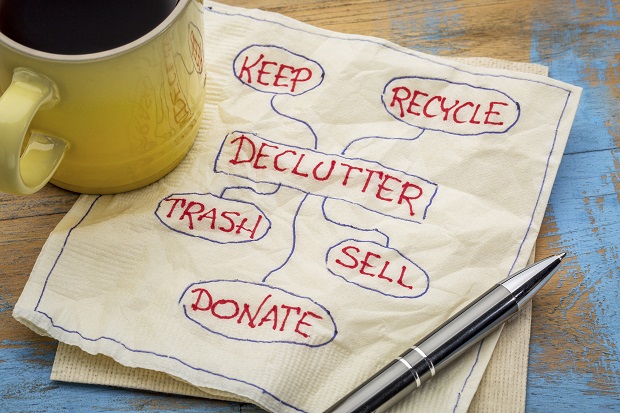Imagine you are taking a trip and need to pack your suitcase. No problem, right? Now, how would it change the situation if you didn’t know where you were going? As you survey your clothes, you might try to include a little of everything to prepare for contingencies. You would probably include duplicates—just in case. You’d bring a nice sweater for dress-up even though you don’t like it as well as your scruffy favorite. Might as well throw that in, too.
Packing for an unknown destination makes decision-making so much harder. In addition to feeling frazzled, your burden includes managing a whole bunch of stuff that you may or may not use.
We all know how it feels to be overwhelmed by too much stuff. As a professional organizer and life coach, I am called into people’s homes to help them navigate the clutter. Most people think that they have a clutter problem. I find the clutter is more like a messenger loudly proclaiming that you have skipped a very important step: honing in on your current life situation, a.k.a. your “destination.”
The step of identifying who you are right now gets bypassed for a couple of reasons. First, you may have experienced life transitions like switching jobs, becoming an empty nester, having a health crisis, or retiring without altering how your home functions. In your mind, you are still cooking for a family of six even though it’s just the two of you. What food buying habits or food preparation habits would change when cooking for two instead of six? When you examine the situation consciously, it’s obvious that what you keep, the quantities you buy, and recipes sizes ought to shift. The key word here is consciously.
I’ve noticed that the transitions that happen earlier in life, such as going to college, getting married or having children require us to intentionally figure out what skills are required, what stuff we will use, and the support we need to rise to the new occasion. In contrast, life transitions later in life might seem to just happen, leading you to look around at the clutter backlog and wonder, “How did I get so much stuff?”
The second reason why someone may have skipped the step of identifying who she is now is that she feels like the best part of her life is over. Getting excited about the future makes sense for eighteen-year-olds. Does it apply when your best friend moves away, your spouse dies, or you have been diagnosed with a chronic condition? What does the process of self-discovery look like then?
These life situations call for consciously enlisting support. Loving, compassionate support brings perspective. It creates a sacred space where you realize you are not alone. You gain a witness to your process. The process actually happens when you have support, rather than building up to more and more toxic levels. We become braver with support.
Clarifying who you are now requires bravery. Before you think, “I’m not brave,” I’m going to stamp my foot and declare that you are both resourceful and resilient. How do I know? Because none of us gets to this point in life without a few (or sometimes many) challenges. Have you ever moved? Experienced the death of a loved one? Thought that something was going to happen a certain way only to find out that you were totally wrong?
Yep. All of us have faced challenges. When that unwelcome, unsettling transition happened, you had to think of ways to adjust, to manage. That’s resourcefulness. In the midst of the dark time, you persisted. It may have taken some time, yet you emerged. That’s resiliency. Claim your bravery, your resourcefulness, and resilience, because it is already there.
I believe that the truth—combined with having the right support and skills—will set you free. If you are burdened by your clutter, you have a choice: to examine the truth of your life now, then align your home and life to match that, or to ignore reality until reality smacks you over the head. Unprocessed life transitions, clutter piles, and ignored feelings don’t just evaporate. They will show up sooner or later, whether you want them to or not.
But why would you wait to begin the rediscovery and realignment process? Clarity allows you to make easier decisions, ones that honor you. The process of rediscovery and realignment facilitates a life review to acknowledge key items that have served you in the past. Letting go becomes easier with “letting go rituals” as discussed in Who Am I Now? Realign Your Home and Life. These rituals can include taking a photo of the object, journaling about why the item is special, or creating a photo book to document your collection.
Challenge the assumption that you are supposed to keep everything forever. Objects have a life cycle. That might mean a birthday card completes its life cycle once it arrives. Perhaps your collection of butterfly art no longer brings you joy. Give yourself permission to pass on items to someone who will enjoy them. By releasing old collections, you create room for new blessings.
What is possible if you listen to what your clutter is telling you? What skills, stuff, and support do you need to pack for your current stage of life? I’m inviting you into this beautiful process of rediscovery and realignment. We are going to have so much fun.




